![]()
![]()
![]()
Use LEFT and RIGHT arrow keys to navigate between flashcards;
Use UP and DOWN arrow keys to flip the card;
H to show hint;
A reads text to speech;
24 Cards in this Set
- Front
- Back
|
Define migration |
Migration may be defined as a process when a person moves to a foreigner country permanently and stays for at least a year. |
|
|
Migration may be classified or divided into |
International & National Inter-rural & Rural-urban Forced & Voluntary |
|
|
Ravenstein's laws / Migrations laws |
-Most migrants proceed over a short distance -Migration occurs in a series of steps or stages -As well as movement to large cities, there is movement away from them (dispersal) -Urban populations migrate less than rural populations -Women are more migratory than men over short distance -Migration increases with advances in technology |
|
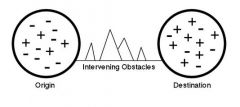
|
Lee's push and pull migration model Intervening obstacles: -Disadvantages (pull factors): Political & cultural differences, -Advantages (push factors): Work & education -Unimportant factors: Distance |
|
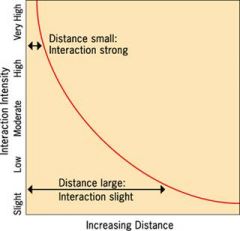
|
Gravity model
Based upon the idea that as the importance of one or both of the location increases, there will also be an increase in movement between them. The farther apart the two locations are, however, the movement between them will be less (distance decay). |
|
|
The Zelinsky Model of Mobility Transition
|
The Zelinsky Model of Mobility Transition
Transition claims that the type of migration that occurs within a country depends on how developed it is or what type of society it is. |
|
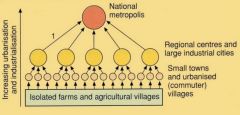
|
Hierarchical stepwise movement Shows types of stepped migratory movement originating from rural areas. It shows the increasing urbanization and industrialization through the progressive movement from rural areas, to small towns, to regional center, to national metropolis |
|
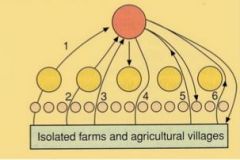
|
Varied stepwise movement Shows the exceptions in the hierarchical model, that movement appears (because of push and pull factors) in various ways. |
|
|
Population density Population distribution |
Distribution: Refers to the way which people are spread out the earth's surface. Density: Describes the number of people living in a given area (Number of people in an area or country/Size of area or country) |
|
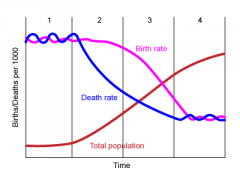
|
Demographic transition model: Is a evolution model which shows changes in total population as a results of changes in the CBR and CDR as a society goes through the process of modernization. 1: High fluctuation 2: Early expansion. Death rate falls, raid pop growth 3: Late expansion. Both birth and death rates falls, pop grows 4: Low fluctuation: Both birth and death rates remains low. Pop remains high. |
|
|
Population momentum |
The tendency for population to grow despite a fall in birth rate or fertility levels. Because of a high concentration of people in prechild-bearing and child-bearing years.
PMF = CBR/1000 x Life expectancy |
|
|
Doubling time |
Is the length of time it takes for a population to double in size, assuming the natural growth rate remains constant.
DT = Life Expectancy (70) / NC |
|
|
Natural Change |
Shows the position in the Demographic Transition Model. NC = CBR - CDR E.g. (46/1000) - (16/1000) x 100 = 3.0% |
|
|
Dependency Ratios |
YDP = YDP / EAP x 100 EDP = EDP / EAP x 100 TDP = YDP + EDP / EAP x 100 |
|
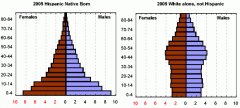
|
1. Concave pyramid: Expansive -> Stationary 2. Convex pyramid: Constructive -> Regressive |
|
|
Population Projection |
The maximum population exception in the future |
|
|
3 Types of densities |
Population density: Total pop/Total area Physiologic density: Total pop/Cultivableland Agricultural density: Rural pop/Cultivableland |
|
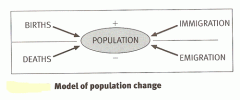
|
The haggettian model: Describes the natural change. Decrease: CDR, emigration |
|
|
Indicators of mortality |
CDR: Numbers of deaths MMR: Women who dies pregnant or complication at childbirth L.E: Expected to live CMR: Deaths of infants and children under 5 ASDR: Death in specific age group ASSDR: Death in specific age and sex group |
|
|
Indicators of fertility |
CBR: Number of births NRR: Daughters that passes through the age-specific fertility and mortality rates GRR: Daughters 45 years and the age-specific fertility rate ASFR: Age of children to the age of women TFR: Children born in a women's lifetime RLF: Amount of daughters to replace herself |
|
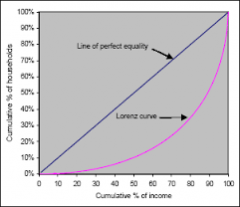
|
Lorenz curve: Shows inequalities in distributions. Diagonal line: Perfect even distribution Concave/convex curve: The degree of concentration of population within the various continents. The greater the slope, the greater the inequality of population distribution |
|
|
Population policies |
May be defined as an institutional official decision to deduce and reduce population growth. Implemented to solve a problem related to CBR. |
|
|
Types of population policies |
1. Anti-natalism (China) 2. Pro-natalism (Germany) |
|
|
Types of population problems |
Explosion, implosion |

